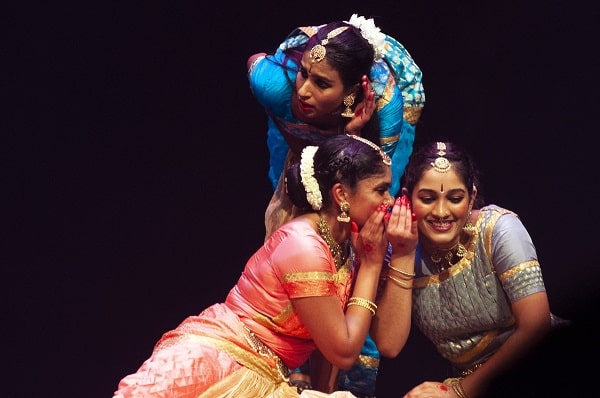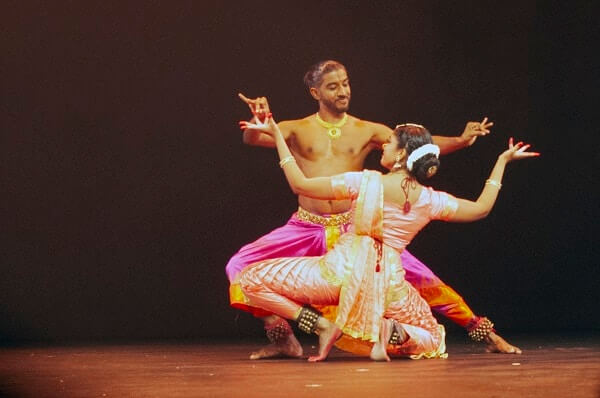Of the nine emotions or ‘rasas’ mentioned in Indian classical dance theory, Sringaram is known as the mother of them all, as it embodies passionate love and all its accompanying affections.
The word ‘sringaram’ in Sanskrit means ‘romantic love, attraction or beauty’. However, it really encapsulates all facets of the word. A well-portrayed notion in Indian dance, music and art, ‘sringaram’ is a highly nuanced and layered concept that presents opportunities to depict other emotions as well, such as jealousy, fear, anger and compassion.
This rasa was embodied in Rasana Dance Theatre’s recent production entitled Sringaram, presented at the Riverside Theatre, Parramatta. Rasana Dance Theatre’s performers delved into the gamut of emotions that surround love and passion through the medium of Bharatanatyam in their portrayal of a tale of love. The brainchild of Seran Sribalan, dancer, choreographer and company founder, the production was much awaited as the many waves of lockdowns in Sydney compelled it to be postponed making the preparation (over three years) and staging of the performance a true labour of love and dedication to the art form.
The dancers Balaki Parameshwaran, Aruthy Kumanan, Durga Shivaji, Sahana Nandakumar and Seran Sribalan along with musicians Arjunan Puveendran (vocal), Chrissan Segaram (mridangam), Venkatesh Sritharan (flute) and Saumya Sritharan (veena) worked seamlessly together to convey the subtleties of the ‘sringaram rasa’ on stage. The show commenced with the energetic and eye-catching Nrittaswaravalli in raga ‘Jog’ and tala ‘Adi’. This introductory piece composed by Venkatesh Sritharan gave the audience a glimpse of what was yet to come, as the deft choreography of dynamic ‘swara’ (musical note) passages launched the evening to a stunning start.

Central to the whole repertoire, the varnam, an aptly titled ‘Sakhiye’ (in raga ‘Anandabhairavi’ and tala ‘Adi’), was composed by the Tanjore Quartet and depicted four sakhis (companions) and a youth who explore the full spectrum of emotions that accompany love. Lead dancers Durga Shivaji and Seran Sribalan rendered these feelings with skilled ease as they possessed the finesse required for such intricate facial expressions. Equally impressive were the dancers who enacted the role of the sakhis as they nimbly navigated through their own individual characters. The varnam was interspersed with fast-paced jathis which involved the dancers in various formations and combinations showcasing a spectacularly unique take on symmetry in dance. This was particularly evident when the dancers leaped in unison and ended in identical postures – a striking sight to behold. The classic trope of a nayika (heroine) adorning herself that is part of ‘sringaram rasa’ was also enacted in the lead dancer’s graceful making of a garland with small delicate movements. Other qualities such as playfulness, jealousy and anger were represented by the accompanying dancers in impeccably exhibited scenes, including a game sequence in which the friends playfully teased the heroine.
The production then delved into an exploration of three ‘Ashtapadi’ – Sanskrit hymns – from the 12th century piece Gita Govindam by poet Jayadeva. Well known for being rooted in the ‘sringaram rasa’, these works were ideal to further illustrate the concept as they embody Radha and Krishna. The items ‘Nindati Chandana’ (raga ‘Darbari Kanada’ and tala ‘Adi’), ‘Yahi Madhava Yahi Keshava’ (raga ‘Dhanyasi’, tala ‘Mishra Chapa, restructured by Arjunan Puveendran) and ‘Priye Charusheele’ (raga ‘Mukhari’ and tala ‘Khanda Chapu’) were presented with effortless transitions in between. Each exploring a different facet of the love between Radha and Krishna, the ashtapadis’ concepts were mirrored in the story of the two lovers whose tale was being told.
To conclude, a particularly vibrant thillana (raga ‘Kuntalavarali’, tala ‘Adi’, composed by BMK) was offered, which emphasised each dancer’s prowess and the poise with which they executed the complex choreography containing various synchronised leaps, turns and spins. The technical precision in the dancers made for crisp geometrical patterns and thus, a sublime viewing experience for the audience.

In light of the various setbacks faced in the production of Rasana Dance Theatre’s Sringaram, it was especially encouraging to patrons of the Sydney classical arts scene to witness the commitment and devotion of the Rasana dancers. What better way to break the performance drought, than with a production on love and its many facets.
READ ALSO: Jiva Parthipan’s The River Project





